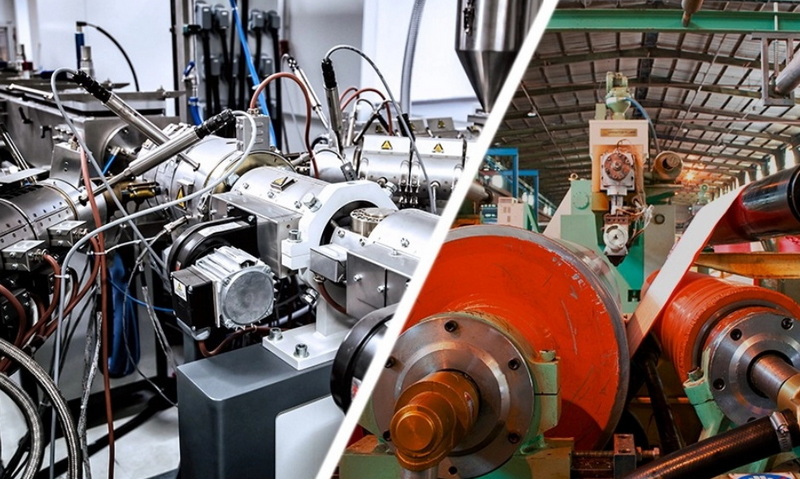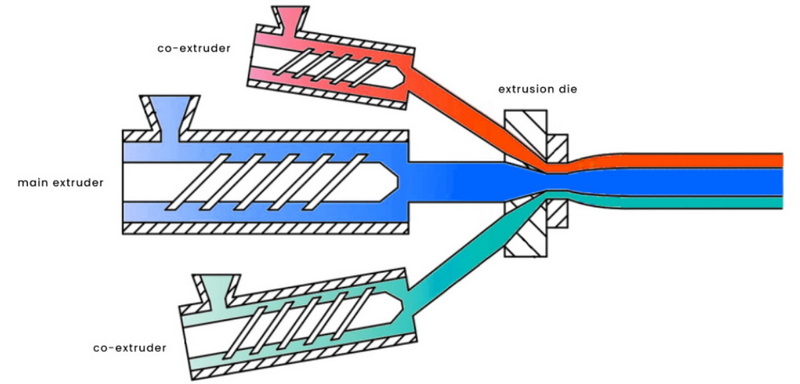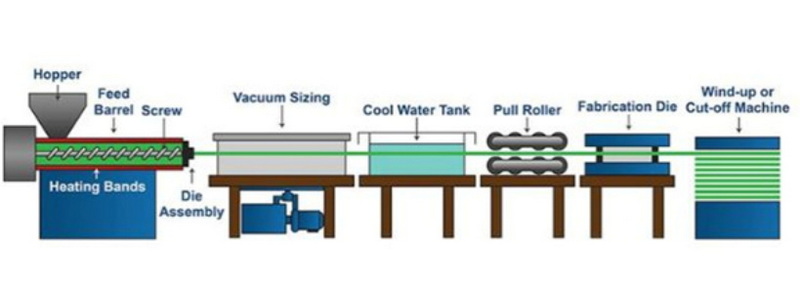Content Menu
● Understanding Co-Extrusion
● Key Benefits of Co-Extrusion Production Lines
● Applications of Co-Extrusion
● Technological Advancements in Co-Extrusion
● Challenges in Co-Extrusion
● Conclusion
● FAQ
>> 1. What is co-extrusion?
>> 2. What are the advantages of using co-extrusion production lines?
>> 3. In which industries is co-extrusion commonly used?
>> 4. What technological advancements have improved co-extrusion processes?
>> 5. What challenges are associated with co-extrusion?
● Citations:
Co-extrusion production lines have revolutionized the manufacturing landscape, particularly in the plastics industry. This innovative process allows for the simultaneous extrusion of two or more materials through a single die, creating complex and multifunctional products. In this article, we will explore the numerous benefits of co-extrusion production lines, their applications, and how they contribute to efficiency and innovation in manufacturing.

Understanding Co-Extrusion
Co-extrusion is a manufacturing process that involves extruding multiple materials simultaneously to form a single product. This technique enables manufacturers to create composite structures with distinct properties, such as enhanced durability, improved aesthetics, and tailored functionality. The process typically involves:
- Multiple Extruders: Each material is fed through a separate extruder before being combined in a die.
- Layering: Different materials can be layered to achieve specific characteristics, such as heat resistance or flexibility.
- Customization: The ability to fine-tune each layer's properties allows for unparalleled customization opportunities.
Key Benefits of Co-Extrusion Production Lines
1. Enhanced Efficiency and Cost Reduction
Co-extrusion simplifies the manufacturing process by consolidating multiple steps into one streamlined operation. This leads to:
- Reduced Equipment Needs: Fewer machines are required, lowering capital expenditures.
- Lower Labor Costs: With fewer processes to manage, less manpower is needed.
- Optimized Resource Utilization: Co-extrusion maximizes material use and minimizes waste, enhancing overall efficiency.
2. Versatile Design Capabilities
One of the most significant advantages of co-extrusion is its ability to blend different materials seamlessly. This versatility allows manufacturers to:
- Create Complex Profiles: Combine various materials with distinct properties into a single product.
- Incorporate Aesthetics: Use different colors and finishes within one profile without secondary processing.
- Tailor Functionality: Design products that meet specific requirements, such as UV protection or chemical resistance.
3. Precision Engineering
Co-extrusion offers exceptional control over material composition and layering. This precision enables:
- Exact Material Placement: Manufacturers can position different materials precisely within the product.
- Consistent Quality: Advanced machinery ensures uniform material flow and layer thickness, maintaining product integrity.
4. Sustainability and Waste Reduction
By optimizing material usage and minimizing waste during production, co-extrusion contributes to more sustainable manufacturing practices. This includes:
- Use of Recycled Materials: Co-extrusion can efficiently incorporate recycled plastics into new products.
- Lower Energy Consumption: Streamlined processes often require less energy compared to traditional methods.
5. Expanded Market Opportunities
The ability to produce customized products with enhanced properties opens up new market opportunities for manufacturers. Industries that benefit from co-extrusion include:
- Automotive: For components requiring lightweight yet durable materials.
- Consumer Goods: For packaging solutions that need both aesthetic appeal and functionality.
- Construction: For building materials that offer thermal insulation or weather resistance.

Applications of Co-Extrusion
Co-extrusion is used across various industries due to its versatility:
- Packaging: Creating multilayer films that provide barrier properties against moisture and oxygen.
- Medical Devices: Producing tubing with different properties for flexibility and biocompatibility.
- Electronics: Manufacturing components that require specific electrical properties or protection from environmental factors.
Technological Advancements in Co-Extrusion
Recent advancements in technology have further enhanced the capabilities of co-extrusion production lines. Key developments include:
- 3D Printing Integration: Combining co-extrusion with 3D printing technology allows for rapid prototyping and testing of complex designs.
- Advanced Machinery: Modern co-extrusion lines are equipped with sophisticated controls for temperature management and material flow, ensuring high-quality outputs.
Challenges in Co-Extrusion
Despite its many benefits, co-extrusion does come with challenges:
- Equipment Costs: The initial investment in multi-extruder setups can be high.
- Material Compatibility: Not all materials can be co-extruded; they must exhibit similar flow characteristics during processing.
- Recycling Issues: Products made from multiple polymers can be difficult to recycle if they cannot be easily separated.
Conclusion
Co-extrusion production lines offer numerous benefits that enhance efficiency, reduce costs, and expand design possibilities in manufacturing. As industries continue to seek innovative solutions to meet consumer demands, co-extrusion stands out as a key driver of progress in product development. By leveraging this advanced technique, manufacturers can create complex, high-performance products that cater to diverse market needs while promoting sustainability through optimized resource utilization.

FAQ
1. What is co-extrusion?
Co-extrusion is a manufacturing process where two or more materials are extruded simultaneously through a single die to create a composite structure with distinct properties.
2. What are the advantages of using co-extrusion production lines?
The advantages include enhanced efficiency, cost reduction, versatile design capabilities, precision engineering, sustainability through waste reduction, and expanded market opportunities.
3. In which industries is co-extrusion commonly used?
Co-extrusion is commonly used in industries such as packaging, automotive, consumer goods, medical devices, and electronics due to its versatility and ability to create customized products.
4. What technological advancements have improved co-extrusion processes?
Recent advancements include the integration of 3D printing technology for rapid prototyping and the development of advanced machinery for better control over temperature management and material flow during production.
5. What challenges are associated with co-extrusion?
Challenges include high equipment costs for multi-extruder setups, compatibility issues between different materials during processing, and difficulties in recycling products made from multiple polymers that cannot be easily separated.
Citations:
[1] https://www.craftedplastics.com/blog/benefits-of-co-extrusion-in-product-development
[2] https://www.kellerplastics.com/what-is-co-extruded-plastic-an-in-depth-guide/
[3] https://www.breyer-extr.com/en/?id=44&component=5
[4] https://www.youtube.com/watch?v=8ObmhbnB1BE
[5] https://www.bausano.com/en/technology/co-extrusion
[6] https://reschcor.com/co-extrusion/
[7] https://www.3erp.com/blog/how-coextrusion-works/
[8] https://optinova.com/news/co-extrusion-why-what-and-how/
[9] https://geminigroup.net/engineered-plastics/profile-extrusion-co-extrusion/manufacturing-capabilities/plastic-co-extrusion/






















